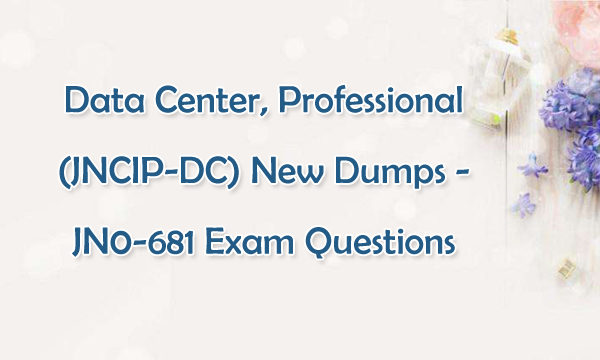Data Center, Professional (JNCIP-DC) New Dumps - JN0-681 Exam Questions
Are you looking for valid study materials to pepare for JN0-681 Data Center, Professional (JNCIP-DC) Certification Exam? Now you can come to PassQuestion to get Data Center, Professional (JNCIP-DC) New Dumps - JN0-681 Exam Questions to pass Juniper JNCIP-DC JN0-681 exam. We provide valid JN0-681 exam questions in two formats. One is pdf file and the other is testing engine. You can practice your JN0-681 PassQuestion practice questions online in both the two formats, then you can pass JN0-681 Data Center, Professional (JNCIP-DC) exam to complete the professional level of Juniper Data Center Certification Track.

Certification Path For Juniper Data Center Certification Track
Juniper Data Center certification track is a program that allows all candidates to demonstrate competence with advanced data center technologies and related configuration and troubleshooting skills. Candidates who hold Data Center Certification demonstrate advanced knowledge of the Junos OS used in a data center environment. To complete Juniper Data Center Certification Track, you need to complete Associate, Specialist, Professional, and Expert the four levels. The four levels are progressive, completing the Associate level is the prerequisite of the Specialist level, and so on.

Junos, Associate (JNCIA-Junos)
Enterprise Routing and Switching, Specialist (JNCIS-ENT)
Data Center, Professional (JNCIP-DC)
Data Center, Expert (JNCIE-DC)
JN0-681 Exam Topics Have 8 Sections
• Multichassis LAG
• Layer 2 Fabrics
• Layer 2 Fabrics
• VXLAN
• EVPN VXLAN Signaling
• Data Center Interconnect
• Data Center Architecture and Security
PassQuestion JN0-681 Exam Questions Contain 65 Practice Questions and Answers
In this scenario, which protocol will accomplish this task?
A. OSPF
B. BGP
C. EVPN
D. PIM
Answer: C
A. Layer 2 data must traverse a point-to-point link.
B. Layer 2 data must traverse an MPLS LSP.
C. Layer 2 data must be encapsulated.
D. Layer 3 data must be encapsulated.
Answer: B
In this scenario, which two solutions will satisfy this requirement? (Choose two.)
A. VXLAN
B. EVPN
C. VMTO
D. VPLS
Answer: AB
In this scenario, how would you accommodate this increase?
A. Decrease the number VXLANs used.
B. Increase the MTU on the physical interface connected to the VXLAN network.
C. Only use switches as VTEPs.
D. Increase the MTU on the VTEP interface connected to the VXLAN network.
Answer: B
In this scenario, what are three advantages of using MPLS EVPN interconnects? (Choose three.)
A. They provide for static configuration that does not require a Dynamic Routing Protocol.
B. They provide for lower transmission latency.
C. They provide for a local proxy ARP/ND resolution.
D. They provide for point-to-multipoint connectivity.
E. They provide for MAC learning in the control plane.
Answer: CDE
In this scenario, what should you do to solve this problem?
A. Use separate vSwitches to isolate each tenant's networks and use IP tables to evaluate inter-tenant traffic.
B. Use VLANs to isolate each tenant's networks and use an SRX Series device to evaluate inter-tenant traffic.
C. Use a vMX device to isolate each tenant's networks and use with firewall filters to evaluate inter-tenant traffic.
D. Use separate vSwitches to isolate each tenant's networks and use a vSRX Series device to evaluate inter-tenant traffic.
Answer: D
In this scenario, what should you configure on the leaf devices to accomplish this task?
A. proxy ARP
B. static ARP entries
C. persistent MAC learning
D. IGMP snooping
Answer: A
A. EVPN learns MAC addresses in the data plane.
B. VPLS learns MAC addresses in the control plane.
C. VPLS learns MAC addresses in the data plane.
D. EVPN learns MAC addresses in the control plane.
Answer: CD
What will satisfy the customer’s requirements?
A. routing instances
B. tenant systems
C. logical systems
D. bridge domains
Answer: A
In this scenario, which statement is true?
A. The routers have not been configured with the multipath multiple-asparameter.
B. The routers have not been configured using the add-pathparameter.
C. The routers have not been configured using the bfd-liveness-detectionparameter.
D. The routers have not been configured using the multihopparameter.
Answer: D
- TOP 50 Exam Questions
-
Exam
All copyrights reserved 2025 PassQuestion NETWORK CO.,LIMITED. All Rights Reserved.

